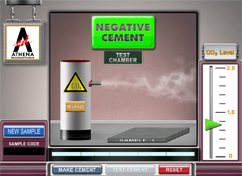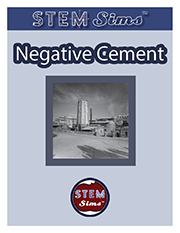Here are some definitions to help you in your investigation.
Substance – a kind of matter that has the same properties all through the matter
Concrete – an important building material
Production – to make something
By-product – an undesired substance made when making something else
Carbon Dioxide – an odorless, colorless gas
Air – a mixture of gases surrounding Earth
Greenhouse Gas – a gas that absorbs heat from the Sun and may lead to climate change
Climate Change – a change in the normal climate of a given region
Concentration – the amount of one thing in something else
Emission – to give off a gas during a process
Reading and Interpreting a Line Graph
What is a Line Graph?
A line graph is a tool that provides a picture using a line or lines to show how things change over time or how they're connected. For instance, you want to see how a plant grows over time. So you measure the plant's height every week. You can use a line graph to see how the plant is growing!
Reading and Interpreting the Graph (See Figure 1.)
• Seeing Changes: Look at the line. If it goes up, the plant is growing! If it stays flat, it's not changing its height, and if the line goes down, the plant is losing height.
• Comparing Weeks: You can easily see which weeks the plant grew the most by looking for the steepest parts of the line.
Finding the Height (See Figure 2.)
• To find the plant height at a certain week, find that Week Number on the bottom line (x-axis), go straight up to the line, and then look across to the Plant Height number on the side (y-axis). On this graph, the plant at week 6 had a height of 9 centimeters.
Extrapolating the Data Beyond the Line (See Figure 3.)
• Following the Trend: If the line is going up or down steadily, you can predict that the plant will continue changing its height at about the same rate in the next few weeks.
• Making a Prediction: You can extend the line a little bit past your last data point (see the dashed line) to make a prediction about the plant's height in the future. But remember, it's just a prediction! Things might change.
Using our extended line in this graph, we predict the plant will have a height of 7 centimeters at week 11.
• Limitations: Extrapolating too far out is not always accurate. The plant could stop growing, or grow at a different rate.
)
What is cement?
Cement is one of the primary ingredients in concrete, acting as the "glue" that holds the concrete together. Cement is a mix of very finely ground minerals, usually limestone, sand, gypsum, clay and other minerals. The most common type of cement is known as "Portland cement".
What materials are used to make cement?
Cement is typically made by mixing water, sand and gravel with limestone and calcium carbonate. Different grades of cement are made with different materials, but this is the basic formula. To make the cement, the raw materials are blended in the correct proportions and ground into a fine powder. The powder is then heated in a kiln, where the intense heat converts it into "clinker," small pellets of calcium silicates, the primary ingredient in cement. The clinker is ground into a very fine powder that is the finished product known as Portland cement.
What is the difference between normal cement and Eco-friendly cement
The primary difference between normal cement and eco-friendly cement is that eco-friendly cement does not use limestone, a primary ingredient of normal cement. The heating of limestone is responsible for 60% of the carbon dioxide emissions resulting from the production of normal cement. The rest of the emissions come from using fossil fuels to heat the kiln. Eco-friendly cement uses magnesium silicates instead of limestone, which means that the raw materials processing step produces no carbon dioxide. In addition, the magnesium silicates don't require extremely high temperatures, so biofuels can be used to heat the kiln.
What is the advantage of Eco-friendly cement?
Normal cement, used in the construction of most buildings, is harmful for the environment, as its production releases large amounts of carbon dioxide gas into the atmosphere. In fact, tests show that cement making accounts for about 5% of worldwide man-made CO2 emissions. Eco-friendly cement is carbon negative, meaning that after complete production, the cement will remove more carbon from the atmosphere than the amount that is used to produce it. Not only does the production process use very little carbon dioxide, but after it is installed, the cement draws CO2 out of the atmosphere air as it hardens over time. In addition, the magnesium silicates that eco-friendly cements use don't have to be heated to extremely high temperatures, so biofuels can be used to heat the kiln instead of fossil fuels.
 Carbon dioxide, CO2, is listed as one of the greenhouse gases associated with global climate change concerns. The production of cement is one process that results in large amounts of CO2 being released into the atmosphere. Your challenge is to mix different kinds of cement and determine not only how much CO2 you can keep from entering Earth’s atmosphere, but also how much CO2 can be absorbed once the cement has been poured.
Carbon dioxide, CO2, is listed as one of the greenhouse gases associated with global climate change concerns. The production of cement is one process that results in large amounts of CO2 being released into the atmosphere. Your challenge is to mix different kinds of cement and determine not only how much CO2 you can keep from entering Earth’s atmosphere, but also how much CO2 can be absorbed once the cement has been poured.)


